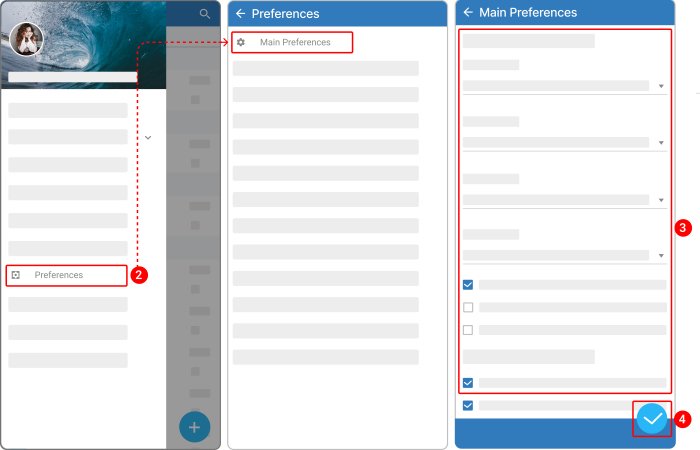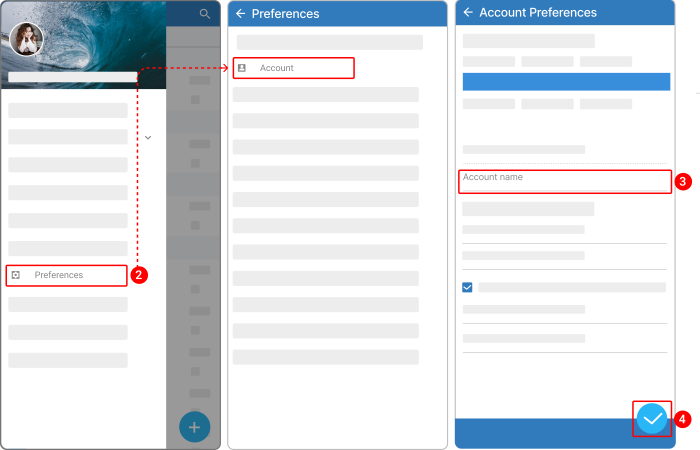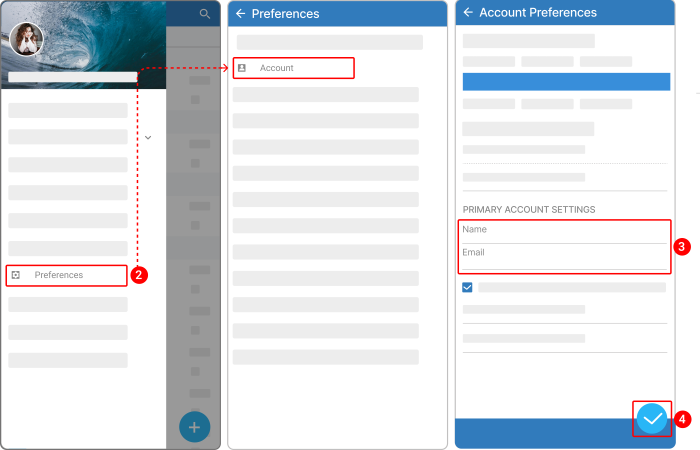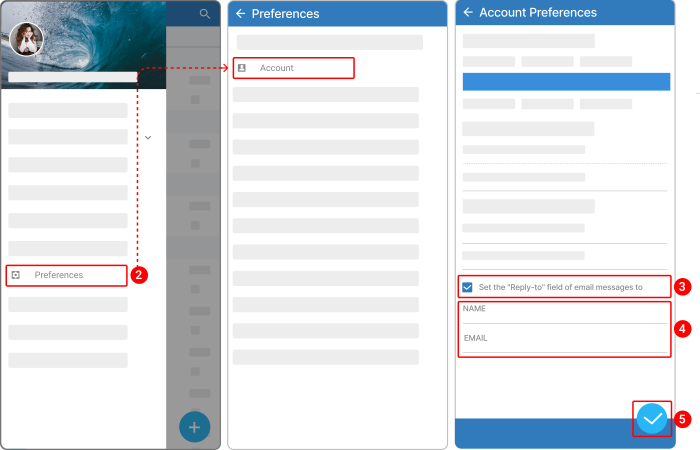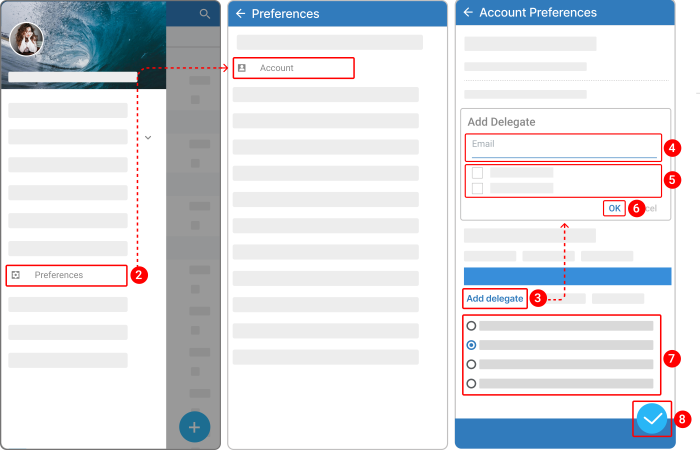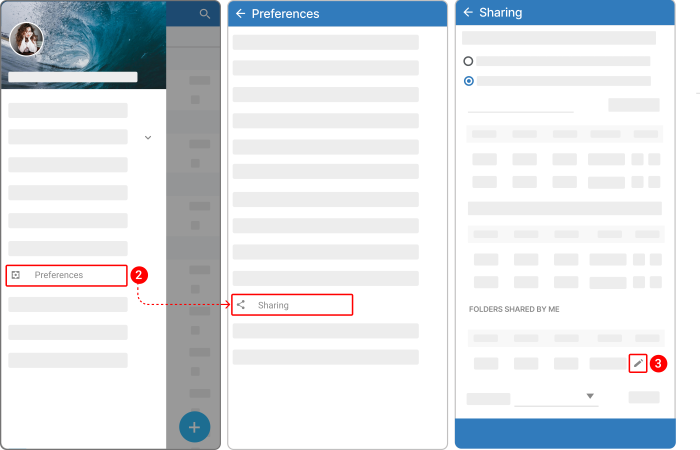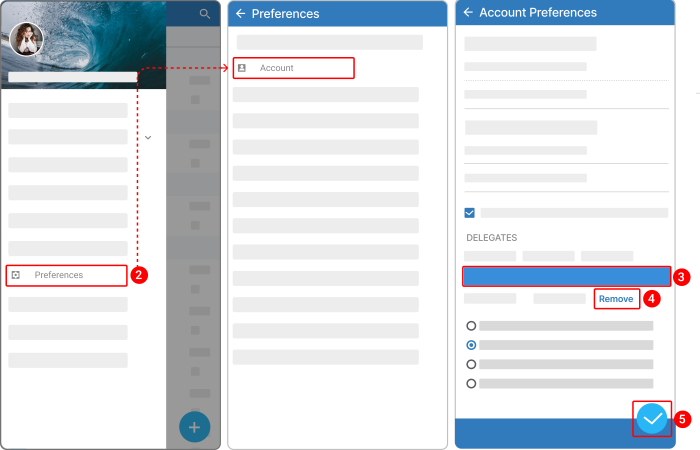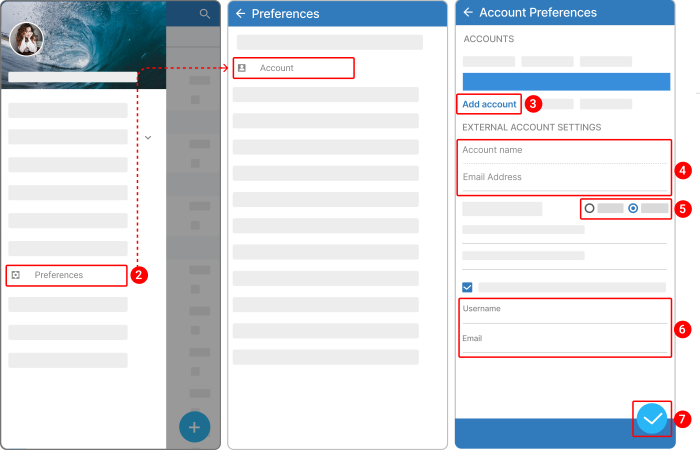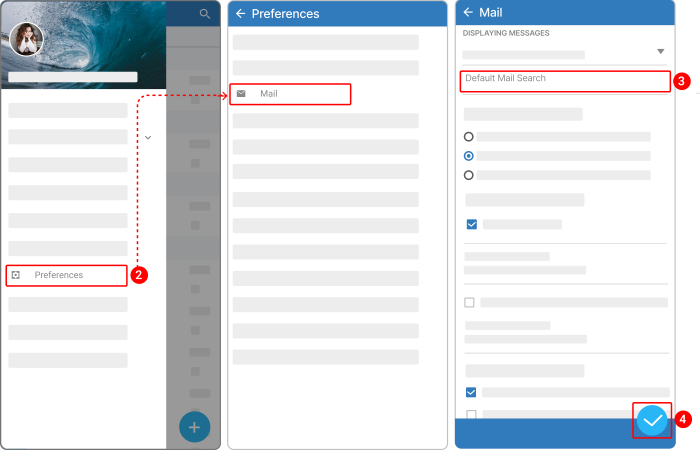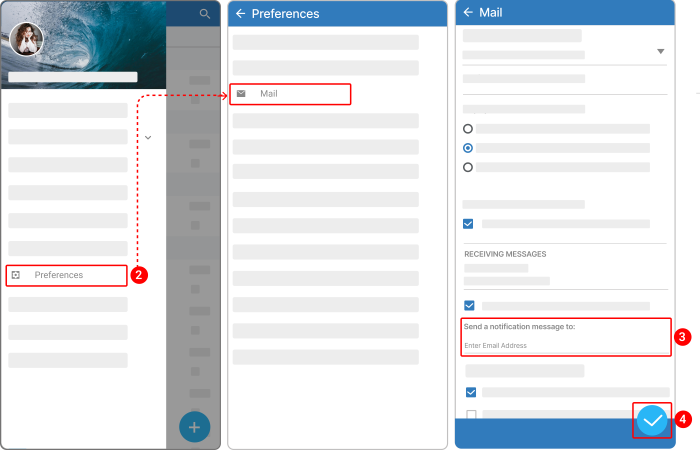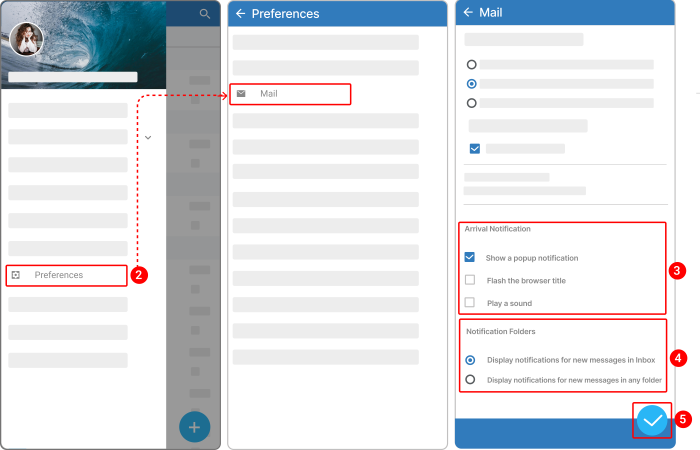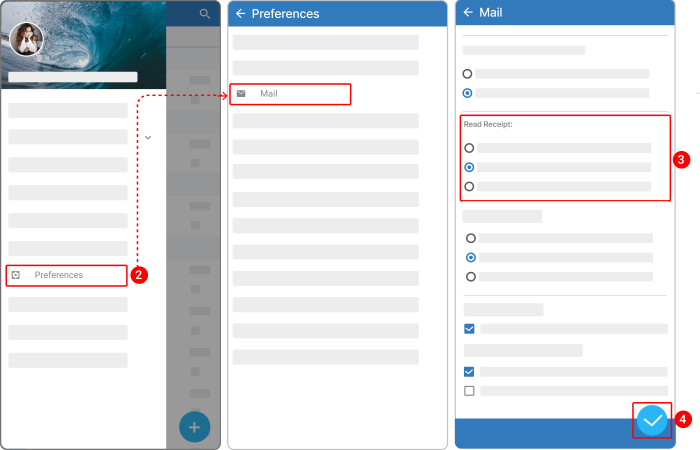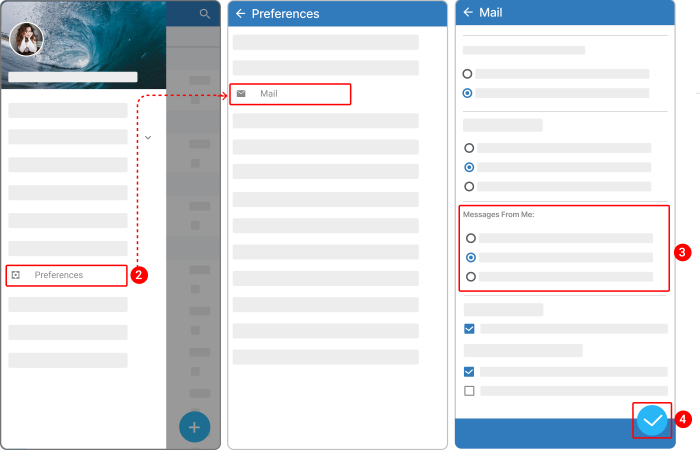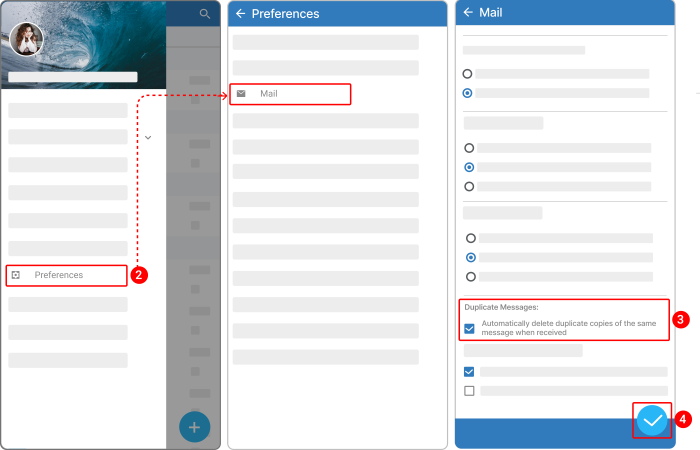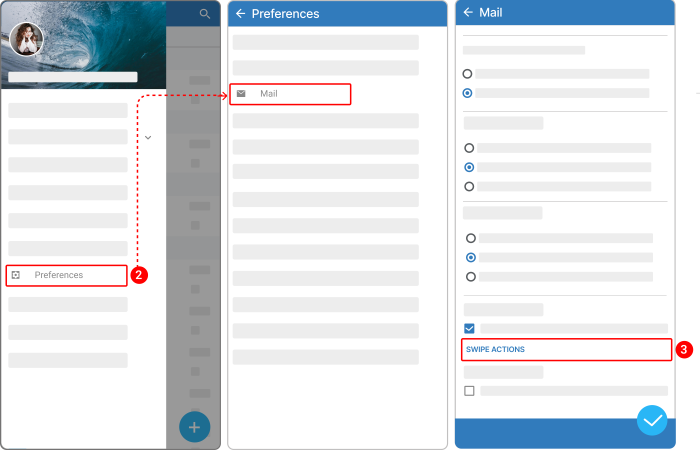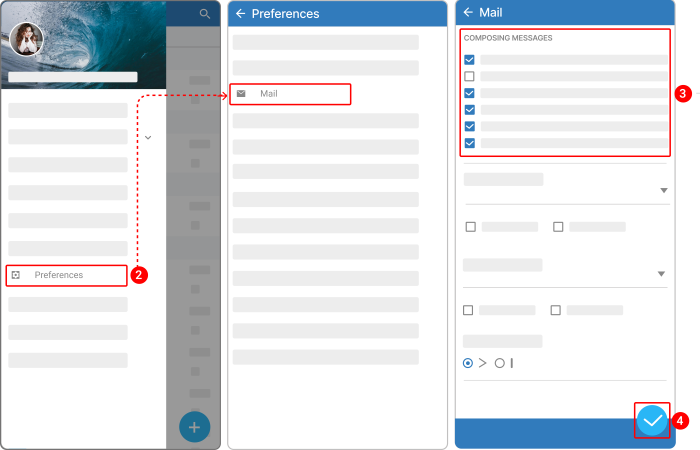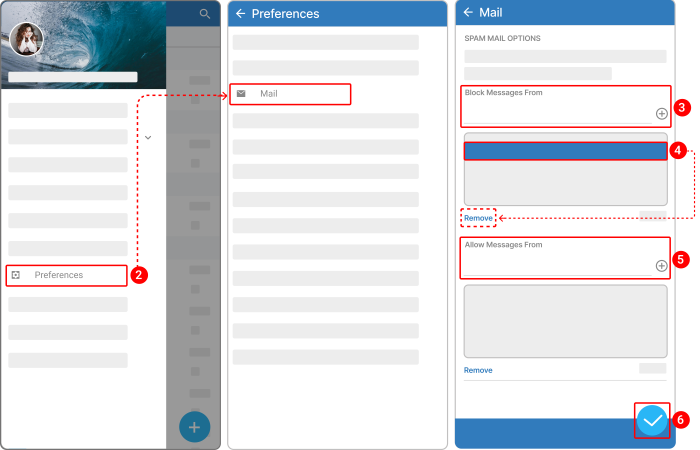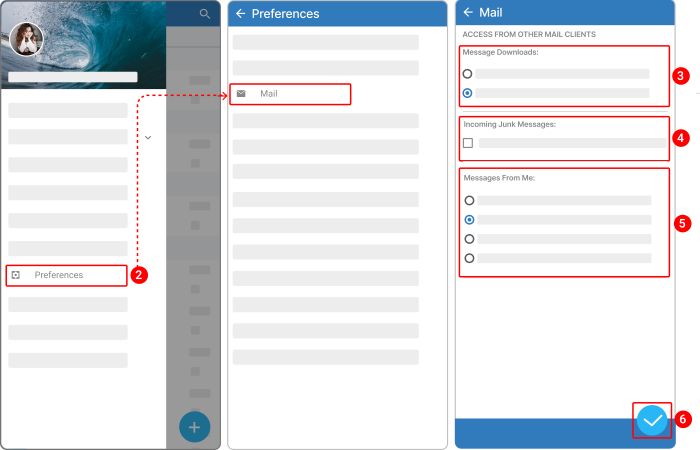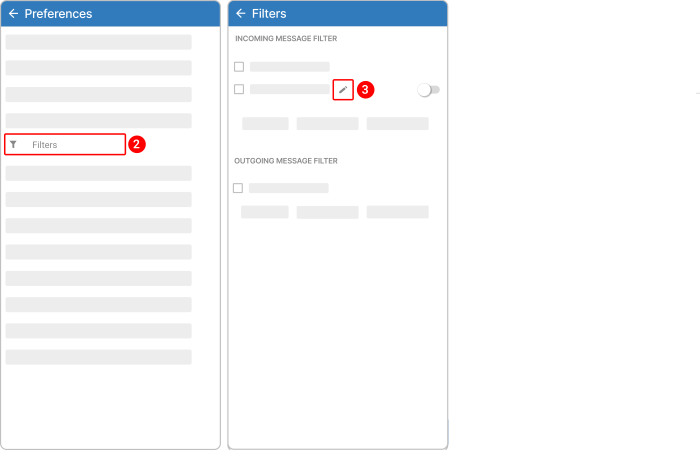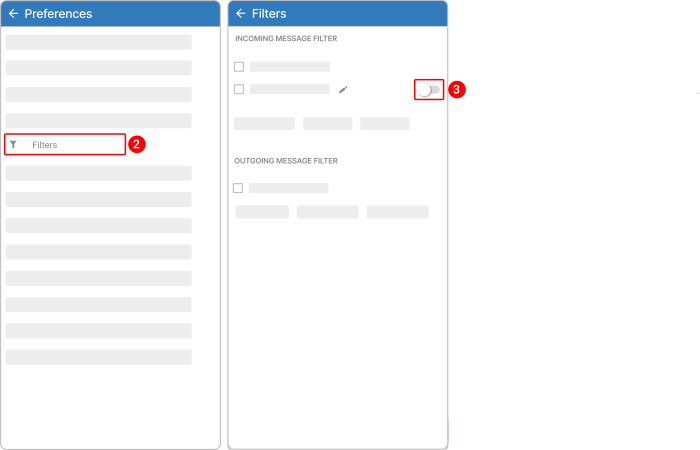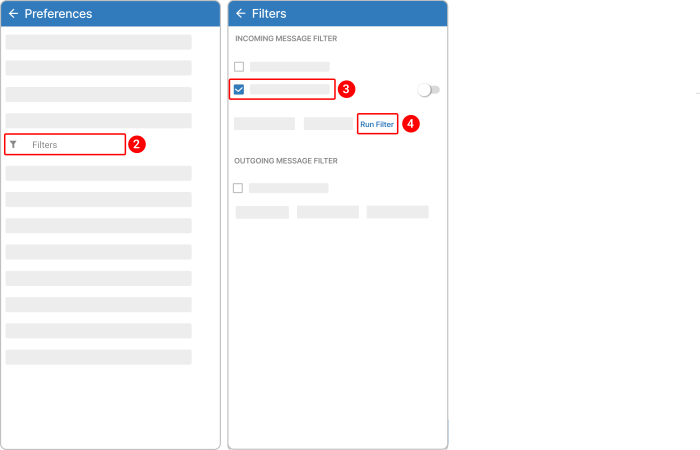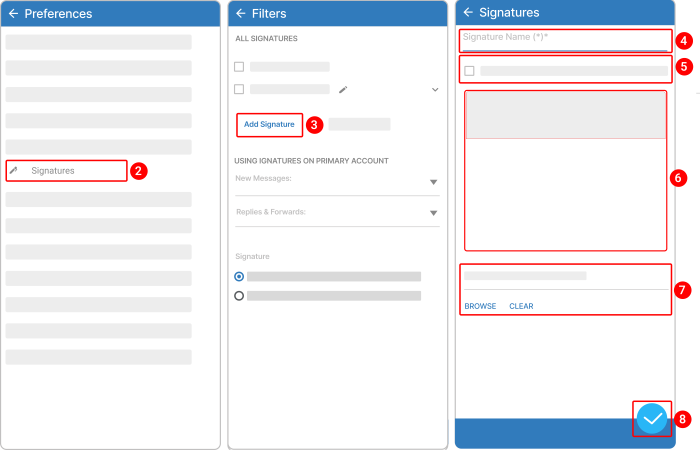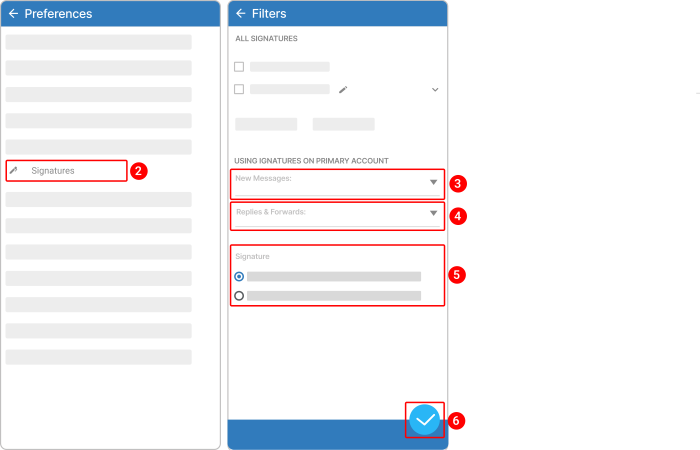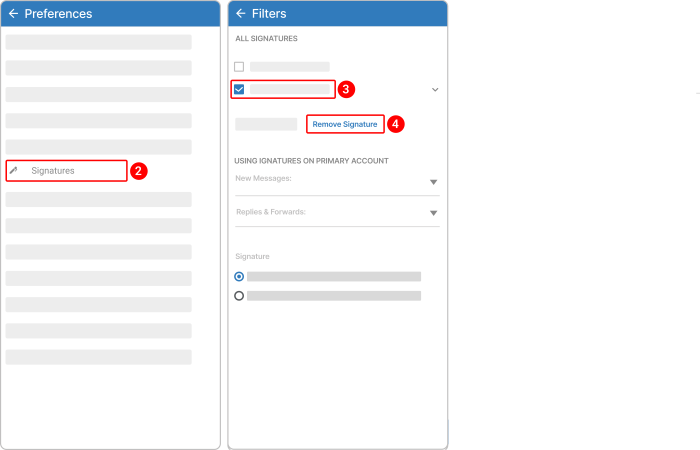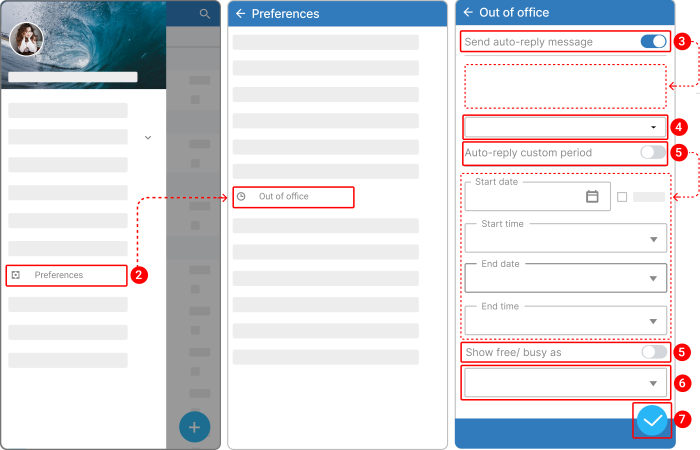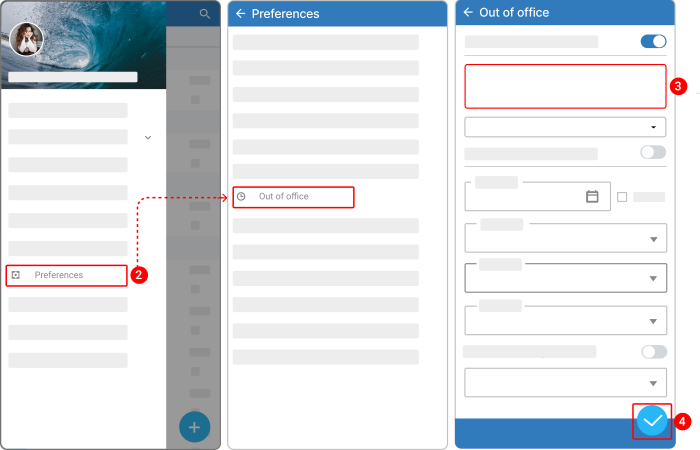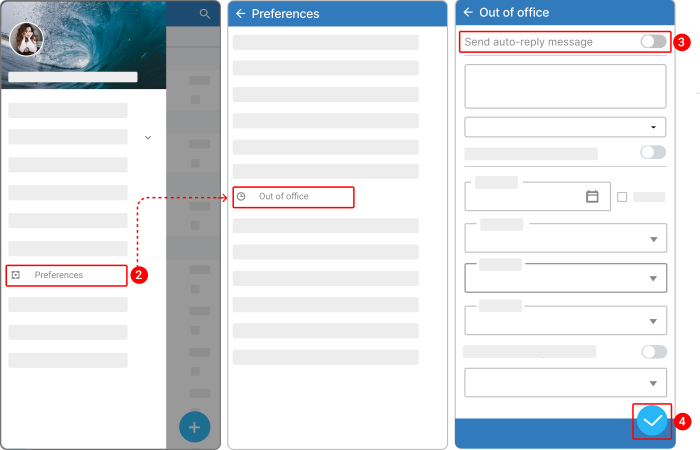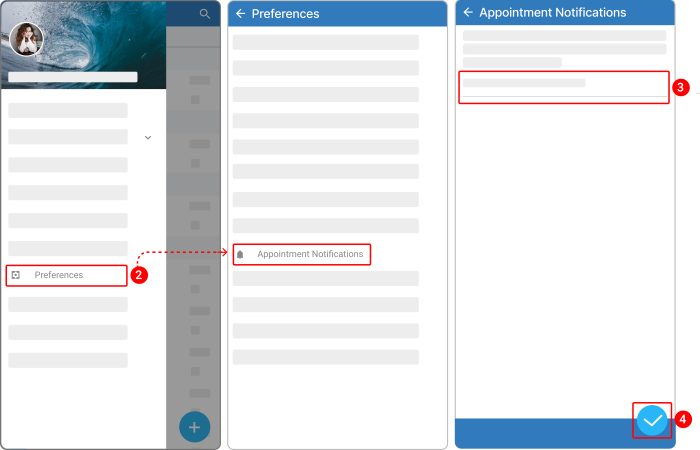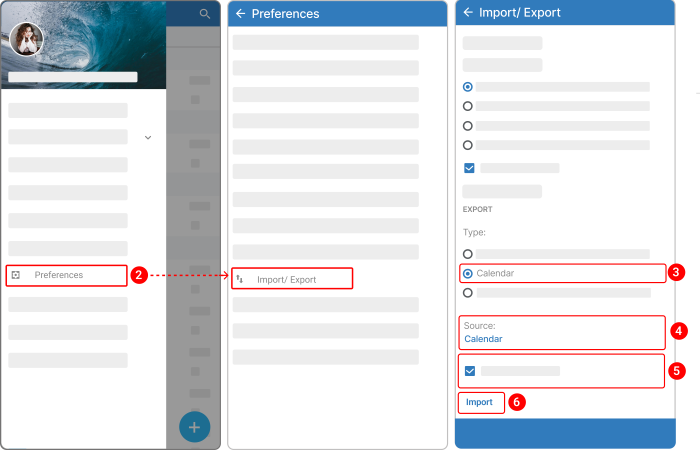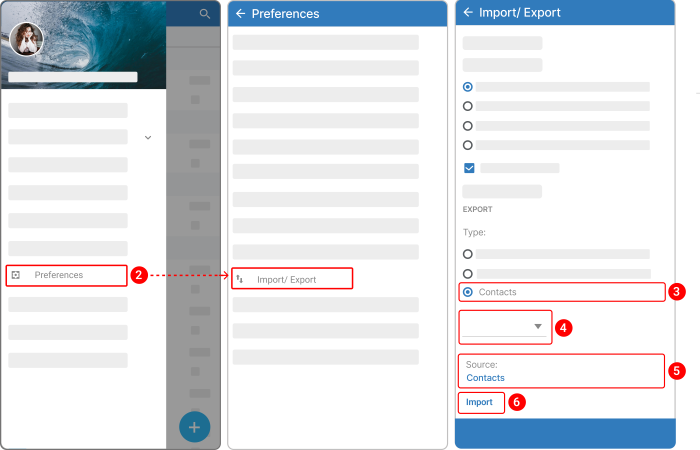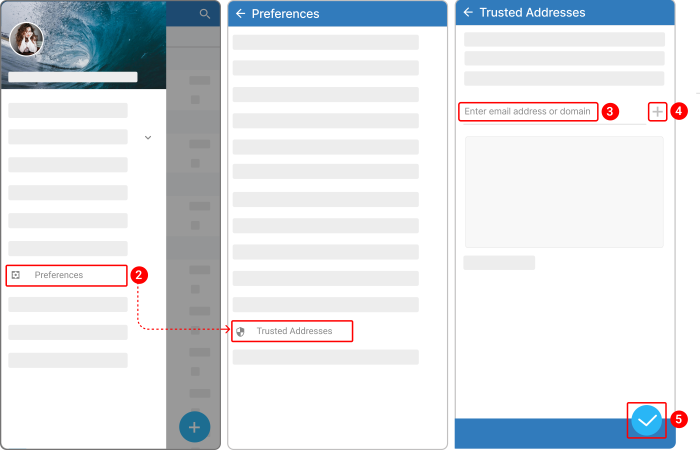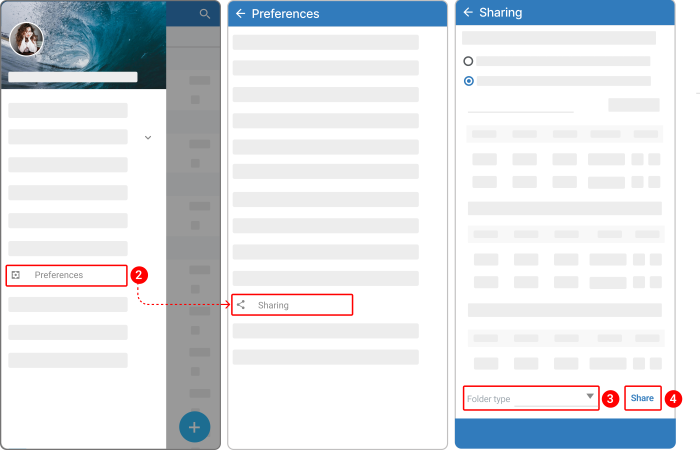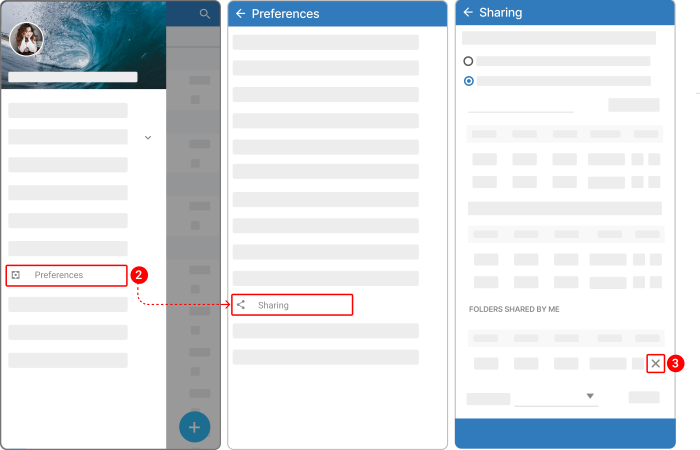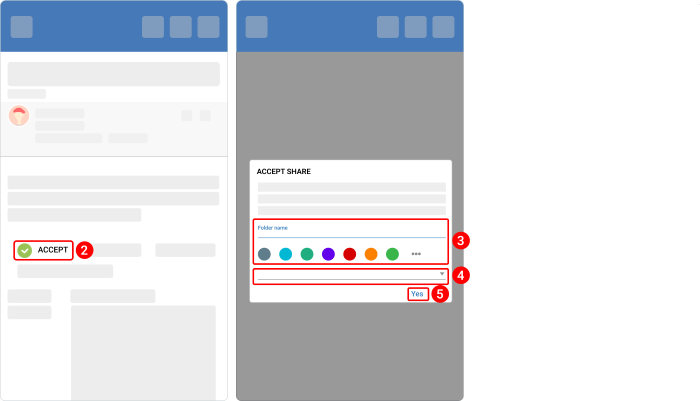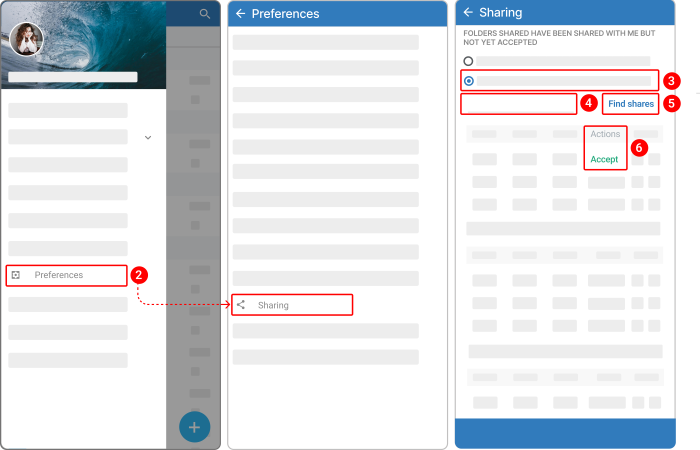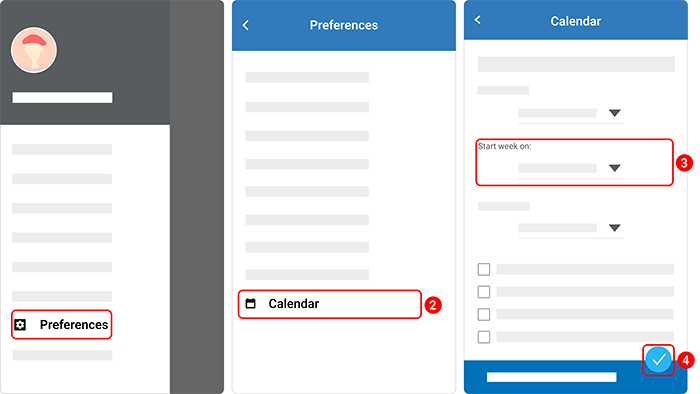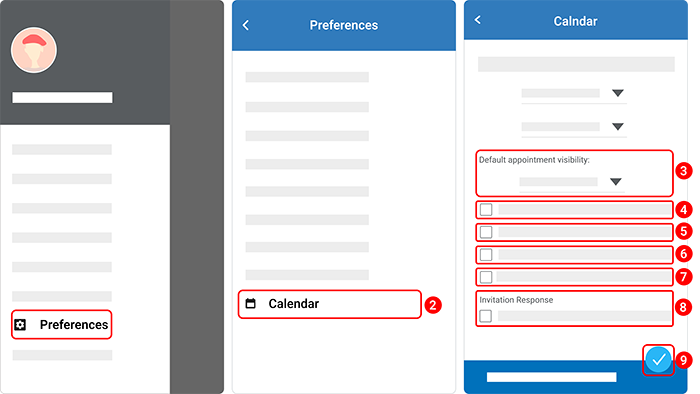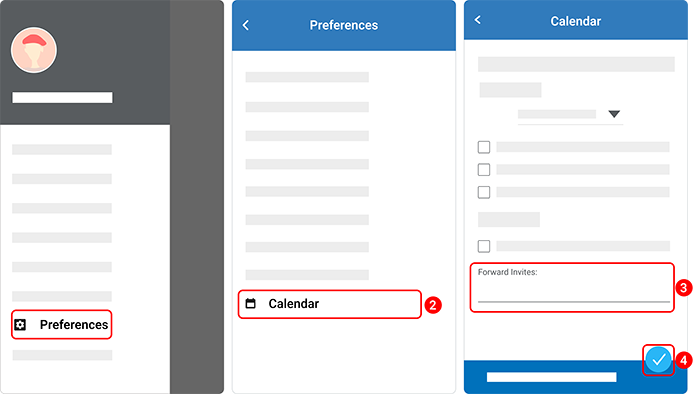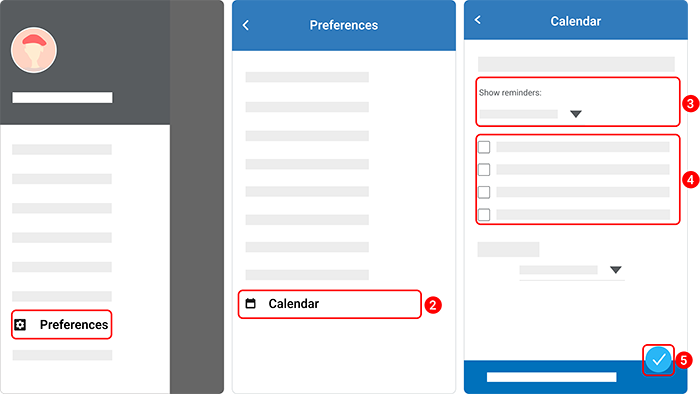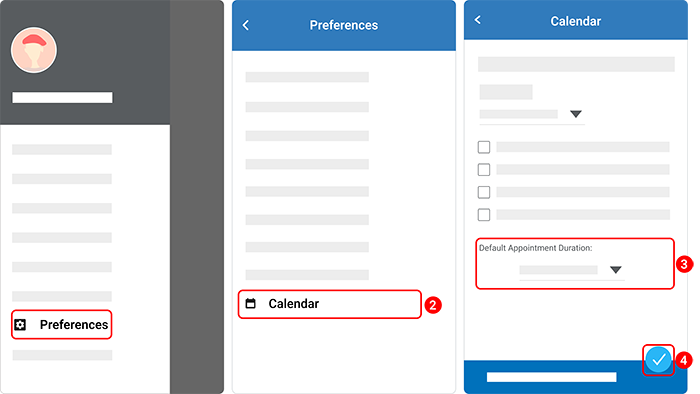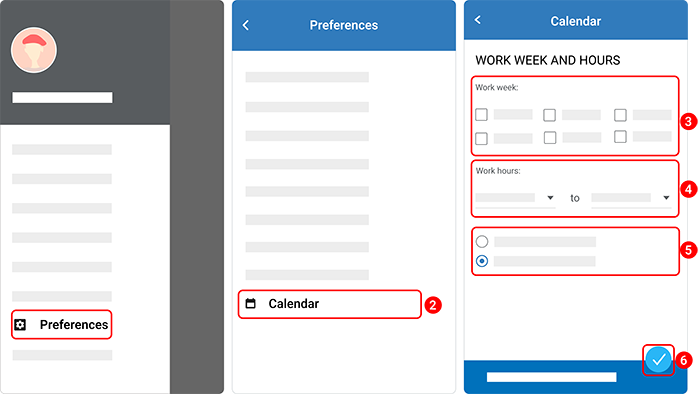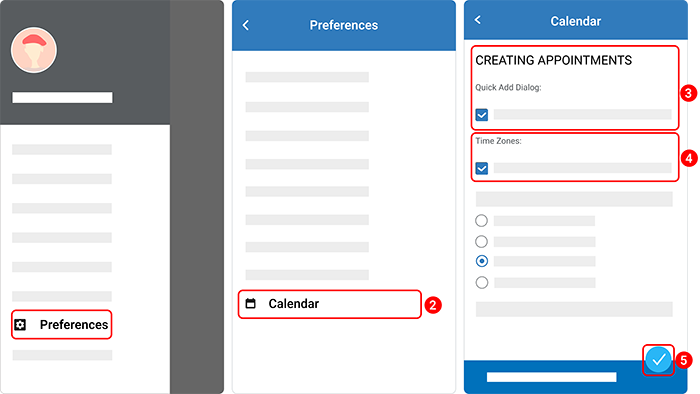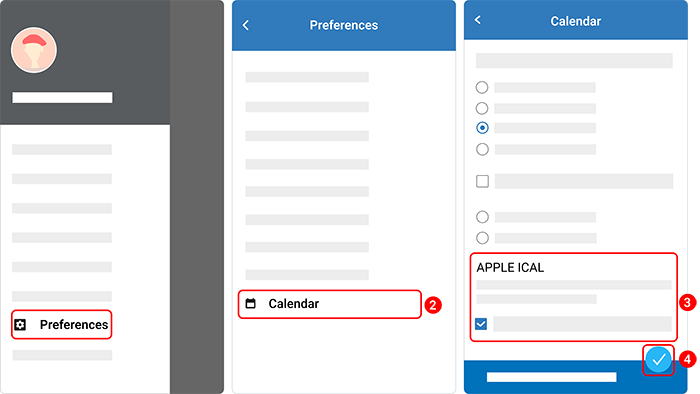Preferences¶
Updated till version 3.0
Main preferences¶
Main preferences allow you to customize language, timezone, theme, and more.
To change your main preferences:
- In the upper left corner, tap the hamburger menu icon
 .
. - Navigate to Preferences > Main preferences.
- Customize your main preferences.
- Tap the checkmark
 at the bottom.
at the bottom.
| Option | Description |
|---|---|
| Timezone | You can change the time zone in VNCmail so that it matches your current location. |
| Language | This option allows you to select the language that you want to use. It is possible to set up 2 languages: English and German. |
| Theme | The "Theme" option allows you to select the background colors for your mailbox interface. VNCmail is the default. |
| Compose direction | The "Compose direction" option allows you to change the direction of your typing composition from right to left. |
| Show direction buttons in compose toolbar | You can select whether to display this feature in the toolbar to be able to toggle or not. |
| Do not load insecure content | You can disable the "Insecure content" message. |
| Search settings | You can choose to automatically include the Spam, Trash, and Share folders in any search you perform. By default, these folders are not searched. |
| Show advanced search language in search toolbar | You can select whether to show search string details in the search field or not. |
Account preferences¶
Account preferences allow you to update your account name, add a signature to your email, grant people (delegates) access to your account, and more.
Update your account name¶
- In the upper left corner, tap the hamburger menu icon
 .
. - Navigate to Preferences > Account.
- Under the "Primary account settings" section, edit the name in the Account name field.
- Tap the checkmark
 at the bottom.
at the bottom.
You should see the notification stating that Preferences saved.
Change your default email account¶
You can change what appears in the “From” field of emails.
- In the upper left corner, tap the hamburger menu icon
 .
. - Navigate to Preferences > Account.
- Under the "Settings for sent messages" section, enter a name in the Name field and select the account you want to use as the default account from the Email dropdown menu.
- Tap the checkmark
 at the bottom.
at the bottom.
You should see the notification stating that Preferences saved.
Change your reply-to address¶
You can add a reply-to address. Replies to emails sent from this address will be delivered to the reply-to address instead.
- In the upper left corner, tap the hamburger menu icon
 .
. - Navigate to Preferences > Account.
- Check the box next to Set the "Reply-to" field of email messages to.
- Enter a username in the Name field and select a required email address from the Email dropdown menu.
- Tap the checkmark
 at the bottom.
at the bottom.
You should see the notification stating that Preferences saved.
Add a signature to your emails¶
To add a signature to your email, follow the instructions from the "Signatures" subsection.
Delegate access to your account¶
You can make someone your delegate and grant them additional permissions to read, create, or send emails in your mailbox.
- In the upper left corner, tap the hamburger menu icon
 .
. - Navigate to Preferences > Account.
- Tap Add Delegate.
- Type the account name of the person whom you want to designate as your delegate.
-
Customize the permission settings:
- Messages sent with Send on Behalf permissions include both the delegate's and your names.
- When a message is sent with Send As permissions, only your name appears.
-
Tap OK.
-
You can also customize Delegate send settings by selecting a required option:
- Save a copy of sent messages to my Sent folder
- Save a copy of sent messages to delegate's Sent folder
- Save a copy of sent messages to delegate's Sent folder and my Sent folder
- Don't save a copy of sent messages
Change delegate access permissions¶
- In the upper left corner, tap the hamburger menu icon
 .
. - Navigate to Preferences > Account.
- Under the "Delegates" section, select the name of the delegate for whom you want to change permissions.
- Tap Edit permissions.
- Select the appropriate level of access for each category.
- Tap the checkmark
 at the bottom.
at the bottom.
Remove a delegate¶
- In the upper left corner, tap the hamburger menu icon
 .
. - Navigate to Preferences > Account.
- Under the "Delegates" section, select the name of the delegate for whom you want to change permissions.
- Tap Remove.
- Tap the checkmark
 at the bottom.
at the bottom.
Add an external email address¶
You can add an external email address and send emails from this email address.
- In the upper left corner, tap the hamburger menu icon
 .
. - Navigate to Preferences > Account.
- Under the "Accounts" section, tap Add account.
- Under the "External account settings" section, add the email address and give it a name.
-
Set the account to pull your mail server either by POP3 or IMAP and supply the username, password, server name, port, and encryption.
- Post Office Protocol (POP) is a simple protocol that only allows downloading messages from your Inbox to your local computer.
- Internet Message Access Protocol (IMAP) is much more advanced and allows you to see all the folders on the mail server.
-
(Optional) Set a custom Reply-to address and a customized signature as well.
- Tap the checkmark
 at the bottom.
at the bottom.
You should see the notification stating that Preferences saved.
Add a persona¶
The ** Add Persona** feature allows you to create a separate email identity to manage different types of emails. For instance, you can create a business persona for your business email and a personal persona for your personal email.
- In the upper left corner, tap the hamburger menu icon
 .
. - Navigate to Preferences > Account.
- Tap Add Persona.
- Give the persona a name
- In the "From" field, type the name and email address. The name and email address you type are shown in the From field of outgoing emails sent using this persona.
-
(Optional) Check the box next to Reply-to and enter the name and email address.
- Replies sent to these emails are automatically directed to the Reply-to address.
-
(Optional) Set a customized signature.
- Select when this persona should be used using the When replying or forwarding messages sent to checkboxes and input fields.
- Tap the checkmark
 at the bottom.
at the bottom.
You should see the notification stating that Preferences saved.
Mail preferences¶
The Mail Preferences page provides many ways to change and customize your VNCmail display.
Change the frequency of checking email¶
You can adjust how often VNCmail checks for new emails.
- In the upper left corner, tap the hamburger menu icon
 .
. - Navigate to Preferences > Mail.
- Under the "Displaying Messages" section, select a preferred option from the Check New Email dropdown menu.
- Tap the checkmark
 at the bottom.
at the bottom.
You should see the notification stating that Preferences saved.
Customize the default mail search¶
The "Default Mail Search" option specifies the initial view when you log into your mailbox. The default search is your Inbox folder. Therefore, when you sign in, the results of your Inbox display.
You can change this to have another folder, tag, or a saved search displayed when you first open the web client.
- In the upper left corner, tap the hamburger menu icon
 .
. - Navigate to Preferences > Mail.
-
Under the "Displaying Messages" section, enter the search keyword, followed by a: (colon) and folder, tag, or a saved search name in the Default Mail Search field. The following table lists some examples to enter in the text box:
- in:inbox (default)
- is:unread To display only unread messages.
- tag:
> To display email messages that are tagged with specific tags. - in:
To display messages that are sent to a specific folder via an email filter.
Change how email is displayed¶
If you see only part of the recipient's name, such as the first name, but you want to see their full name, you can easily make the desired change.
- In the upper left corner, tap the hamburger menu icon
 .
. - Navigate to Preferences > Mail.
-
Under the "Display email user names" section, select how the email sender name will be displayed in your mailbox:
- First name
- First name, last name
- Email only
-
Under the "Message Preview" section, check the box next to Display snippets of messages in email list to preview an email before you open it.
- Tap the checkmark
 at the bottom.
at the bottom.
Turn on automatic forwarding¶
You can choose to let you automatically forward to another account one or more messages you receive.
- In the upper left corner, tap the hamburger menu icon
 .
. - Navigate to Preferences > Mail.
- Under the "Receiving Messages" section, specify an address in the Message Arrival: Forward a copy to text field to forward your email to.
- If you don't want a copy of the original message to remain in your mailbox, check the box next to Remove a local copy of message.
- Tap the checkmark
 at the bottom.
at the bottom.
Add alternate email address for notifications¶
You can configure your preferences to notify another mail address when new mail arrives in your mailbox. It’s a feature that can be useful also, for example, in situations when you have an account where you don’t receive many emails but you want to know when something arrives.
- In the upper left corner, tap the hamburger menu icon
 .
. - Navigate to Preferences > Mail.
- Under the "Receiving Messages" section, specify an address in the Send a notification message to field to get a notification message.
- Tap the checkmark
 at the bottom.
at the bottom.
Customize arrival notifications¶
When receiving a message you can set how you want to be notified.
- In the upper left corner, tap the hamburger menu icon
 .
. - Navigate to Preferences > Mail.
-
Under the "Arrival notifications" section, select one of the following options:
- Show a popup notification. A popup comes out with information about the message.
- Flash the browser title. The mail tab is highlighted while you are not working on that.
- Play a sound. The browser will flash until you open the mail tab.
-
Under the "Notification Folders" section, select one of the following options:
- Display notifications for new messages in Inbox
- Display notifications for new messages in any folder
Set read receipt preferences¶
You can set your preferences for messages that are flagged with a return receipt request.
- In the upper left corner, tap the hamburger menu icon
 .
. - Navigate to Preferences > Mail.
-
Under the "Read Receipt" section, set your preferences:
- Never send a read receipt. This is the default. When a message is received with a return read receipt request, the request is ignored. The recipient is not aware of the request.
- Always send a read receipt message. A return read receipt message is automatically sent when the message flagged for return read receipt is opened.
- Ask me. Recipients are asked if they want to send the return receipt.
Configure the "Message from me" section¶
- In the upper left corner, tap the hamburger menu icon
 .
. - Navigate to Preferences > Mail.
- Under the "Messages from me" section, select where to place messages sent by you.
- Tap the checkmark
 at the bottom.
at the bottom.
Automatically delete duplicate emails¶
- In the upper left corner, tap the hamburger menu icon
 .
. - Navigate to Preferences > Mail.
- Under the "Duplicate Messages" section, check the box next to Automatically delete duplicate copies of the same message when received.
- Tap the checkmark
 at the bottom.
at the bottom.
Customize swipe actions¶
In the VNCmail app, the default swipe actions are "Move to" and "Delete", these can be changed to other favorite actions.
- In the upper left corner, tap the hamburger menu icon
 .
. - Navigate to Preferences > Mail.
- Tap SWIPE ACTIONS.
- Under the "Right swipe/ Left swipe" section, tap CHANGE.
- Select a preferred option.
Customize options for composing messages¶
Use Composing messages settings to change options for messages that you create.
- In the upper left corner, tap the hamburger menu icon
 .
. - Navigate to Preferences > Mail.
-
Under the "Composing messages" section, select the options for how you want to manage composing messages:
- Automatically save drafts of messages while you are composing. While you compose your message, a copy will be saved in your Draft folder.
- Mandatory spellcheck before sending a message. Check the box to enable mandatory spellcheck of your emails before they are sent.
- Save a copy to Sent folder. This is enabled by default. You can deselect this option.
- Use keyboard shortcut "Ctrl+Enter" to send message. You can select to use the keyboard shortcut Ctrl+Enter to send a message. If you enable this option, be aware when using this keyboard shortcut to complete your message before using it.
- Use quick reply. With quick replies, you can create shortcuts for the messages you frequently send to your recipients.
- Always show quoted text. Select whether to show the quoted text in the body of your reply.
Change how the original message appears in replies and forwards¶
When you reply to or forward an email message, the original message is included above the new message.
You have the option to exclude the original message, including the original message as an attachment, or change the appearance of the original message by using indention or indention prefixed with a vertical line.
- In the upper left corner, tap the hamburger menu icon
 .
. - Navigate to Preferences > Mail.
-
Select from the "Email Reply" dropdown menu whether to include the original text in the body of your reply message:
- Include last message only. (default)
- Include original message as an attachment.
- Include original message.
- Don't include original message.
-
Select from the "Email Forwarding" dropdown menu how to include the original text of a message when you forward a message:
- Include last message only. (default)
- Include original message as an attachment.
-
Under the "Prefix" section, select the prefix to use for reply messages and forwarded messages.
- Tap the checkmark
 at the bottom.
at the bottom.
Customize the spam settings¶
You can identify email addresses that you always want to block messages from being added to your Inbox and email addresses you want to make sure are always added to your Inbox and not sent to Spam.
- In the upper left corner, tap the hamburger menu icon
 .
. - Navigate to Preferences > Mail.
- Under the "Block messages from" section, enter the email address in the field and tap the plus icon.
- If you blocked someone by mistake, you can unblock them by tapping their email address in the blocked email address list and then the Remove button.
- Under the "Allow messages from" section, you can identify email addresses you want to make sure are always added to your Inbox and not sent to Spam.
- Tap the checkmark
 at the bottom.
at the bottom.
Configure the POP access behavior¶
If you are set up to use a POP client, you can configure the POP access behavior when messages are downloaded.
- In the upper left corner, tap the hamburger menu icon
 .
. - Navigate to Preferences > Mail.
- Under the "Message downloads" section, select whether to download all mail or only new mail.
- If you want to include the emails that are in the Junk folder, check the box next to Include Junk folder messages.
- Under the "Incoming Deleted Messages" section, select whether to remove all incoming deleted messages or leave them.
- Tap the checkmark
 at the bottom.
at the bottom.
Filters¶
You can manage your incoming and outgoing mail using filters to move an email to a specific folder, delete, mark, or automatically redirect to another address.
Create a filter¶
Filtering allows you to define rules for managing your incoming and outgoing emails.
You can filter your incoming and outgoing emails to sort them into folders, automatically tag them, forward them, or discard them. For example, you can create a rule as follows:
- All emails from your project manager go into the "Management" folder.
- All emails from the "corporate-events" mailing list are tagged with the "Events" tag.
To create a filter, do the following:
- In the upper left corner, tap the hamburger menu icon
 .
. - Navigate to Preferences > Filters.
- Tap Add filter.
-
Give the filter a name.
- Be sure to name the filter something relevant to the task you will have it do, as differentiating it from others is important. The example is named "Spam Level".
- For example, the "Spam Level" filter is intended to move any emails with a spam rating of 6 or higher into a folder named "Junk". But first, it is needed to specify what to look for.
-
Tap the any/ all dropdown and select a grouping preference:
- Any means that if any of the conditions in the filter are met, apply the action.
- All means that all of the conditions in the filter must be met to apply the filter action.
-
Under the "Filter Condition" section, specify rules the filter will follow.
- As an example, you have specified one simple subject filter that contains headers with "X-Spam-Level" over 6. Any emails received with more than 6*'s will be put into junk.
- To add new rules, click the green Add Condition and it will create a new row.
-
Under the "Action" section, select the actions you want to set for your filter.
- The example says to move the message into the folder "Junk".
Edit a filter¶
- In the upper left corner, tap the hamburger menu icon
 .
. - Navigate to Preferences > Filters.
- Tap the pencil icon
 next to the filter you want to edit.
next to the filter you want to edit. - Edit the filter.
- Tap the checkmark
 at the bottom.
at the bottom.
Delete a filter¶
- In the upper left corner, tap the hamburger menu icon
 .
. - Navigate to Preferences > Filters.
- Check the box next to the filter you want to remove.
- Tap Remove Filter.
Run a filter¶
Once a filter is created, the emails undergo filter processing and are classified accordingly. However, the email messages received before the filter was created will not be processed. To process the previously received email messages in a particular folder, using a newly created filter, you can use the Run Filter option.
- In the upper left corner, tap the hamburger menu icon
 .
. - Navigate to Preferences > Filters.
- Check the box next to the required filter.
- Tap Run Filter.
- Select the folder whose emails you want to classify with this filter.
- Tap OK.
The email messages in the selected folder will be processed according to the filter parameters and classified.
Make a filter inactive¶
You can turn a filter off. If a filter is inactive, it is ignored. Making a filter inactive allows you to keep it for later use rather than deleting it.
- In the upper left corner, tap the hamburger menu icon
 .
. - Navigate to Preferences > Filters.
- Switch off the toggle next to the filter you want to make inactive.
Signatures¶
An email signature is a text that is automatically inserted at the end of an email message you send. An email signature can contain images, links to the social media pages of your organization, and clickable call-to-action. You can even add your corporate logo as an image in your Signature. You can also provide your recipients with your job title, organization details, and contact details.
Create a signature¶
- In the upper left corner, tap the hamburger menu icon
 .
. - Navigate to Preferences > Signatures.
- Tap Add Signature.
- Give the signature a name.
- (Optional) If you want to format the signature text in plain text, check the box next to Format As Plain Text.
- Enter the details of the signature in the text box. If you uncheck the box next to Format As Plain Text, you can add an image, change the text style, or create links to your signature text.
- (Optional) If you want to attach a contact as vCard to your signature, type the account name in the field.
- Tap the checkmark
 at the bottom.
at the bottom.
Add a signature to an account/ persona¶
- In the upper left corner, tap the hamburger menu icon
 .
. - Navigate to Preferences > Signatures.
- Select the name of the signature from the New Messages dropdown menu to include this signature in newly composed messages.
- Select the name of the signature from the Replies & Forwards dropdown menu to include this signature in replies and forwards.
-
Under the Signature Placement section, select one of the following options:
- the Above included messages to add your signature at the end of your reply and before the included messages,
- the Below included messages to add your signature at the end of the message.
Edit a signature¶
- In the upper left corner, tap the hamburger menu icon
 .
. - Navigate to Preferences > Signatures.
- Tap the pencil icon
 next to the signature you want to edit.
next to the signature you want to edit. - Edit the signature.
- Tap the checkmark
 at the bottom.
at the bottom.
Delete a signature¶
- In the upper left corner, tap the hamburger menu icon
 .
. - Navigate to Preferences > Signatures.
- Check the box next to the filter you want to remove.
- Tap Remove Signature.
Out of office¶
The "Out of office" option allows composing an auto-reply message for received emails if you are out of the office. When people send you an email message, they'll receive an email response containing what you have written in your "Out of Office" message.
Enable an "Out of Office" reply¶
- In the upper left corner, tap the hamburger menu icon
 .
. - Navigate to Preferences > Out of office.
- Toggle on Send auto-reply message and then enter an auto-reply message in the text box below.
-
Under the "External senders" section, select one of the following options:
- Send standard auto-reply message if you want to send the "Out of Office" message to all the senders.
- Send custom message to those not in my organization to open a text box and type a separate message for senders who are not in your organization.
- Send custom message to those not in my organization and address book to open a text box and type a separate message for senders who are not in your organization or address book.
- Don't send an auto-reply message to an external sender to avoid sending an out-of-office response to external senders.
-
Toggle on Auto-reply custom period and select the start and end date. When the end date has passed no reply will be sent anymore.
- (Optional) If you want to block your Calendar during your "Out of Office" period, toggle on Show free/ busy as and then select to show yourself in the Calender either as Out of Office or Busy.
- Tap the checkmark
 at the bottom.
at the bottom.
By default, all your "Out of Office" messages will be saved in your Sent folder.
Edit an "Out of Office" reply¶
- In the upper left corner, tap the hamburger menu icon
 .
. - Navigate to Preferences > Out of office.
- Edit the "Out of Office" reply's details.
- Tap the checkmark
 at the bottom.
at the bottom.
Disable an "Out of Office" reply¶
- In the upper left corner, tap the hamburger menu icon
 .
. - Navigate to Preferences > Out of office.
- Toggle off Send auto-reply message.
Appointment notifications¶
In VNCcalendar, all notifications for appointments are sent to the email address configured for email notification. By default, your primary email address is set as the email notification address. You can also change the email address if required.
Enable email reminder¶
- In the upper left corner, tap the hamburger menu icon
 .
. - Navigate to Preferences > Appointment Notifications.
- Under the "Notify" section, enter an email address to which you want to receive the appointment notifications.
- Tap the checkmark
 at the bottom.
at the bottom.
Keep in mind that you need to check the box next to Email under the "Remind" section when creating a new appointment.
Import/ Export¶
You can export your account data to save them in your device as a backup or move them to other accounts or programs. The original data that has been copied into your device remains safe and won’t be removed from your account.
- Account data will be saved as a .tgz file on your computer.
- Contact folders and calendar folders can be also exported individually. In that case, they are saved respectively as .csv and .ics files. These files can be easily imported into your account whenever you need them.
Import your account data¶
- In the upper left corner, tap the hamburger menu icon
 .
. - Navigate to Preferences > Import/ Export.
- Under the "Import" section, tap Browse and select the .tgz, .csv, or .ics file to upload.
- In the "Destination" field select a folder where you want to import the file.
-
Under the "Resolve duplicates" section, select how you want to deal with emails and contacts:
- Ignore. Duplicate files are not resolved. All files are added back and the existing version of an item is kept.
- Modify. Existing contacts and calendar data are updated, not replaced.
- Replace. Items that have changed since the account data was exported are reverted to the version in the exported file. Old items are added back. New items that have been added to your account since the exported file was created are retained.
- Reset. When this is selected, all items of the selected type under the selected folder are removed before importing new items.
-
(Optional) Check the box next to Advanced Settings, if you want to specify which application data to be imported in the Data types field.
- Tap Import.
Export your account data¶
- In the upper left corner, tap the hamburger menu icon
 .
. - Navigate to Preferences > Import/Export.
- Under the "Type" section, select Account.
- In the "Source" field, select the folder you need to export.
-
(Optional) Check the box next to Advanced Settings to open further options:
- Optionally you can specify which application data to be exported in the Data types field
- Optionally you can specify a time period in the Date field to export only the data in the time period
- Optionally you can specify a query in the Search filter field to export only the data that matches the query, for example, has: attachment
- Optionally you can check the Only export content files, exclude metadata in the Other field if you want to import the data into a non-VNCmail email account
-
Tap Export.
After the process is complete the account data is saved as a .tgz file.
Export calendar data¶
- In the upper left corner, tap the hamburger menu icon
 .
. - Navigate to Preferences > Import/Export.
- Under the "Type" section, select Calendar.
- In the "Source" field, tap Calendar and select the calendar that you want to export.
- Tap Export.
After the process is complete the calendar data is saved as a .ics file.
Export contact data¶
- In the upper left corner, tap the hamburger menu icon
 .
. - Navigate to Preferences > Import/Export.
- Under the "Type" section, select Contacts.
-
From the dropdown menu, select Account Contacts to export contacts in its original format, or select other formats:
- Outlook 2003 contacts
- Outlook contacts
- Thunderbird
- Account contacts (this keeps the contact information in the same format it is in)
- Windows Live Contacts
- Yahoo contacts
-
In the "Source" field, select the folder you need to export.
- Tap Export.
After the process is complete the contact data is saved as a .csv file organized in the format you specified.
Trusted Addresses¶
The "Trusted Addresses" option allows you to:
- Create the list with trusted email addresses (it means that the emails from addresses added to the trusted list are sent to the inbox without any spam checks)
- Delete trusted email addresses from the list.
Add email to "Trusted Addresses" list¶
If you notice that embedded images in the email you receive are not automatically displayed, you can add the related addresses to Trusted Addresses so that from now on they will display automatically images.
- In the upper left corner, tap the hamburger menu icon
 .
. - Navigate to Preferences > Trusted Addresses.
- Enter an email address in the field.
- Tap the plus icon next to the email address.
- Tap the checkmark
 at the bottom.
at the bottom.
The given email address will be added to the "Trusted Addresses" list.
Delete email from "Trusted Addresses" list¶
- In the upper left corner, tap the hamburger menu icon
 .
. - Navigate to Preferences > Trusted Addresses.
- Select the required email address from the list.
- Tap Remove at the bottom.
- Tap the checkmark
 at the bottom.
at the bottom.
Sharing¶
The "Sharing" option allows you to give specific internal and external users access to folders in your account. You specify which items to share and the level of access.
Share a folder¶
You can share your mail folders, address books, calendars, and task list folders. You invite a user to share, and the user can accept or decline the invitation.
- In the upper left corner, tap the hamburger menu icon
 .
. - Navigate to Preferences > Sharing.
-
Under the Folder type section, tap the Mail Folder dropdown menu and select the type of the folder:
- Mail Folder
- Calendar
- Contacts Folder
- Task Folder
- Briefcase
-
Tap Share.
- Select the folder that you want to share.
- Under the Share with section, select whether you want to share with external guests or other users of VNCmail.
-
Depending on with whom you share, do the following:
- For Internal users, enter the user’s email addresses. Under the Role section, select the access privileges.
- For External guests, enter the user’s email addresses. External guests are sent an email message with a link to the shared item. They create a display name and password the first time they go to view the shared item.
-
Set the sending parameters:
- Do not send mail about this share. If you do not want the users to get the notification message when you share a folder with them.
- Send standard message. If you want the users to get the notification message when you share a folder with them
- Add note to standard message. If you want to add a note to the notification message. If you select this option, you should fill in the appeared Message field
-
Tap Share.
Change permissions to a shared folder¶
You can change the share permissions that you have assigned to a user.
- In the upper left corner, tap the hamburger menu icon
 .
. - Navigate to Preferences > Sharing.
- Under the Folders shared by me section, tap the pencil icon
 next to the required folder.
next to the required folder. -
Change the privileges.
- You can temporarily disable access to a shared folder without revoking the share privileges by selecting None.
-
Choose whether you want to inform the user via email.
- Tap Share.
Revoke the access to a shared folder¶
You can remove user access to a shared folder.
- In the upper left corner, tap the hamburger menu icon
 .
. - Navigate to Preferences > Sharing.
- Under the Folders shared by me section, tap the cross icon
 next to the required folder.
next to the required folder. - Tap Revoke to confirm.
Accept an invitation to a shared folder¶
There are 2 ways to accept a shared folder.
Way 1. Using the "Accept" button in an email.
- Open a notification email.
- Tap Accept.
- (Optional) Change the folder name and select a color to highlight the folder.
- Choose whether to send a confirmation to the person who sent the invitation.
- Tap Yes.
Way 2. Navigating to "Preferences > Sharing".
- In the upper left corner, tap the hamburger menu icon
 .
. - Navigate to Preferences > Sharing.
- Under the Folders shared have been shared with me but not yet accepted section, select Show folders shared with me by the following user.
- Enter the name of the user, whose shared folder you want to accept.
- Tap Find Shares.
- Tap Accept in the Action column next to the required folder.
- The further steps are the same as for the first way of accepting an invitation to a shared folder.
Calendar prefeneces¶
The Calendar option allows you to choose which day of the week the Calendar starts with, customize the work week and hours, change appointment settings, and more.
Change calendar view¶
The calendar view can be customized to display a single day, work week, full week, whole month or display your events in a list. The default is by work week.
- In the upper left corner, tap the hamburger menu icon
 .
. - Navigate to Preferences > Calendar.
-
From the Default View dropdown menu, select one of the following options:
- Day View - if you want a calendar to display a present day;
- Work Week View - if you want a calendar to display 5 days of the week;
- Three Day View - if you want a calendar to display 3 days of the week;
- Month View - if you want a calendar to display a current month;
- List View - if you want a calendar to display the appointments list.
Change view settings¶
You can specify which day of the week should be the first day of the week in your calendar.
- In the upper left corner, tap the hamburger menu icon
 .
. - Navigate to Preferences > Calendar.
- From the Start week on dropdown menu, select one of the options.
Change appointment visibility¶
This can be set to either Public or Private. The default is "Public", all incoming calendar invites are marked as Public unless the creator marked the meeting notification as private. When this is set to "Private", all incoming calendar invites are marked as Private. Details about events that are marked private are not displayed.
- In the upper left corner, tap the hamburger menu icon
 .
. - Navigate to Preferences > Calendar.
- From the Default appointment visibility dropdown menu, select Public or Private.
Enable/ disable the mini-calendar¶
You can specify whether the mini-calendar is displayed at the bottom of the Overview pane.
- In the upper left corner, tap the hamburger menu icon
 .
. - Navigate to Preferences > Calendar.
- Check/ uncheck the box next to Always show the mini-calendar.
Show/ hide week numbers on the calendar¶
You can specify whether the week numbers are displayed on the mini-calendar.
- In the upper left corner, tap the hamburger menu icon
 .
. - Navigate to Preferences > Calendar.
- Check/ uncheck the box next to Show Calendars with week number.
Automatically add received appointments to the calendar¶
Email invitations sent to your Inbox can be automatically added to your calendar. You can accept or decline the invite from either the Inbox or Calendar.
When this option is not checked, the appointment is added to your calendar when you click "Accept" or "Tentative" in the message.
- In the upper left corner, tap the hamburger menu icon
 .
. - Navigate to Preferences > Calendar.
- Check/ uncheck the box next to Automatically add received appointments to calendar.
Show/ hide a declined meeting on the calendar¶
When you decline a meeting, the meeting continues to display on your calendar in a faded view. You can set your preferences so that the meetings you decline do not display in your calendar.
- In the upper left corner, tap the hamburger menu icon
 .
. - Navigate to Preferences > Calendar.
- Check/ uncheck the box next to Show declined meetings.
Enable/ Disable the "Delete invite on reply" option¶
You can specify whether or not to delete meeting invitations when you respond to them in email. By default, invites are deleted (moved to the "Trash" folder) when you respond to them.
- In the upper left corner, tap the hamburger menu icon
 .
. - Navigate to Preferences > Calendar.
- Check/ uncheck the box next to Delete invite on reply.
Forward invites to an appointment¶
You can forward invite emails you receive to one or more users that you have shared your calendar with.
- In the upper left corner, tap the hamburger menu icon
 .
. - Navigate to Preferences > Calendar.
- Under the Forward Invites section, enter the email address you want to forward the appointment invite.
- Tap the checkmark
 at the bottom.
at the bottom.
Customize reminders for appointments¶
You can change the default reminder time (the default is 5 minutes) and set the type of notification to receive.
- In the upper left corner, tap the hamburger menu icon
 .
. - Navigate to Preferences > Calendar.
- Under the Show reminders section, tap the "5 minutes before" dropdown and select the time before which you want to receive the reminders.
-
Select how you want to be notified:
- Show reminders for past-due meetings. If enabled, VNCmail will send you an email reminder and show a pop-up to remind you.
- Play a sound. If enabled, you will be notified by a beep.
- Flash the browser title. If enabled, the browser will flash until you open the "Mail" tab.
- Show a popup notification. If enabled, information about the appointment will be displayed.
Change default appointment duration¶
By default, when you create a new appointment, the appointment duration is 60 minutes. However, you can increase or decrease the default appointment duration.
- In the upper left corner, tap the hamburger menu icon
 .
. - Navigate to Preferences > Calendar.
- Under the Default Appointment Duration section, click the "60 minutes" dropdown and select the preferred option.
- Tap the checkmark
 at the bottom.
at the bottom.
Customize the work week and hours¶
You can select the days and times of the week you work. You can also customize work hours by day. This information is displayed in your free/busy view.
- In the upper left corner, tap the hamburger menu icon
 .
. - Navigate to Preferences > Calendar.
- Under the Work week section, check the box next to the days of the week you work.
- Under the Work hours section, select the times you work.
-
(Optional) If you need to customize working hours for each working day, select Custom and then click the CUSTOMIZE button.
- To set your days of work, check the days you are in the office and uncheck the days you are not working.
- To set the hours of your workday, select the start of your workday using the first dropdown menu, and select the end of your workday using the second dropdown menu.
- Note: Take note of the time zone indicated. If it is not correct, then your workday hours will be off, as will your calendar times.
Customize the options for appointment creation¶
You can specify whether to create new appointments using the Quick Add Apponitement dialog box.
- In the upper left corner, tap the hamburger menu icon
 .
. - Navigate to Preferences > Calendar.
- Under the Creating Appointments section, check the box next to Use the Quick Add dialog when creating new appointments if you want to have the possibility to create a new appointment by clicking the required date. It means that if you open a calendar and click any date, you should see the Quick Add Dialog.
- Check the box next to Show time zone for the start and end time when creating an appointment if you want the time zone to be displayed while creating an appointment.
- Tap the checkmark
 at the bottom.
at the bottom.
Customize appointment permissions¶
Users, for whom you want to customize appointments permissions, should be present in this mail system. You can use a full email address or just a username.
The free/ busy feature allows others to see appointment times scheduled on your calendar. The free/busy feature is on by default, but you can limit who can see the information.
- In the upper left corner, tap the hamburger menu icon
 .
. - Navigate to Preferences > Calendar.
-
Under the Permissions section, select the Free/ Busy option that you want to set for this calendar:
- Allow both internal and external users to see my free/busy information. This is the default. Anyone can see your free/ busy times.
- Allow only users of internal domains to see my free/busy information. Only internal users can see your free/busy time on your calendars.
- Allow only users of my domain to see my free/busy information. Only internal users of your domain can see your free/busy time on your calendars.
- Don't let anyone see my free/busy time. Your free/busy time cannot be seen.
- Allow only the following internal users to see my free/busy information. Only internal user addresses you list on this page can see your free/busy times.
-
(Optional) If you select the Allow only the following internal user to see my free/busy information option, you should enter a user's email address in the field below. If you want to add several email addresses, start typing a user's email address/ username and tap them.
-
Under the Invites section, specify who can invite you to meetings.
- Allow both internal and external users to invite me to meetings. This is the default. Anyone can invite you to meetings.
- Allow only internal users to invite me to meetings. Only internal users can invite you to meetings.
- Don’t let anyone invite me to meetings. Nobody can invite you to meetings.
- Allow only the following internal users to invite me to meetings. Only internal user addresses you list on this page can invite you to meetings.
-
(Optional) If you select Allow only the following internal user to invite me to meetings, you should enter a user's email address in the field below. If you want to add several email addresses, start typing a user's email address/ username and tap them.
- If you limit who can invite you to appointments, you can check the box next to Send auto-reply to users who are denied from inviting me.
- Tap the checkmark
 at the bottom.
at the bottom.
Enable Apple iCal¶
Apple iCal can be configured to access your calendars using the CalDAV protocol. When this is enabled, shared calendars are displayed in the iCal Accounts Delegation tab on an Apple Mac computer. When this is disabled, all shared calendars display in the Calendars list.
